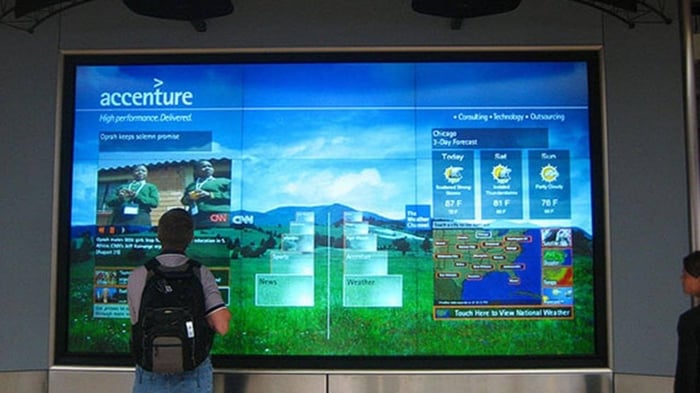When you walk through a building like a mall or an airport where there is a lot of signage, and often much of that signage is advertising, you might either feel somewhat interrupted as you travel to your destination, or you might feel helped by finding a “just-in-time” building directory, pertinent advertising or other relevant piece of information that you can use. Such wayfinding can exist at many scales…from being located within a building to being displayed prominently on a street as a billboard. And today, such signage is getting a facelift not only to become more digital, but to be more interactive — which is bringing with it a new kind of personalization for those passersby.
Of course, such interactive signage in the form of advertisements was taken to one extreme in movies like Minority Report. And while, on one hand, that brings with it all kinds of issues about what that kind of interactivity (where public advertisements appear personalized to you as you walk down the street) might do to privacy (as has been shown to be a concern by many people), there are some practical applications today which can be extracted from those Minority Reportportrayals. And these can serve to improve not only the aesthetics of building signage, but also the usefulness and helpfulness of the information which appears on that signage.
Making wayfinding a better experience includes tackling issues that deal with timing, understanding the demographics of those that will experience that signage and a designer having a more intimate understanding of how people perceive, process, and respond. While more interactivity is emerging on the façades of commercial buildings, it becomes evermore important for designers to take a look at how such signage can better “harmonize” with those buildings upon which they rest. As an example, take a look at the following video of an interactive McDonald’s billboard. While you watch, see if you think it is aesthetically pleasing, and whether or not you think it works on a cognitive and behavioral level for those that experience it.
While some might argue that this billboard does pose somewhat of an aesthetic threat, it does bring forward an interesting idea for me. Perhaps signage on and within buildings can allow viewers to “select” what they want to see and when. Hence, privacy would be respected while the advertised information would increase its likelihood of being relevant and helpful. The start of such interactive billboards can be seen in the two images as shown below:

Image Credit: © myuibe | Flickr
Now, to take this a step further…
What might happen if such “interactive billboards” integrated themselves into buildings to become adaptable walls, floors, ceilings and so forth? With just the right surface presenting just the right information at just the right time, I think buildings could more seamlessly function by freeing up space within them as well as engaging occupants in new and exciting ways.
Such large-scaled interactive “displays” might be good incentive to get you as an architect thinking about what more walls, pathways, gathering areas and other such building features can do. Integrating situation-appropriate kinds of experiences at just the right time will unleash refreshing kinds of meaning that can be brought to those who travel within your architectural spaces.
Image Credit: © luisvilla | Flickr




